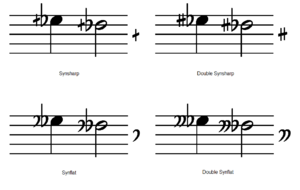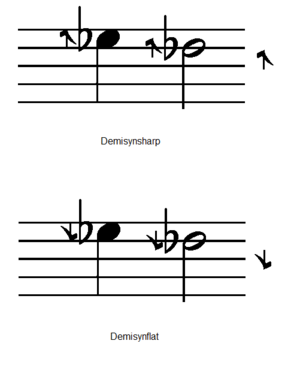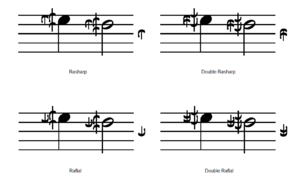Syntonic–rastmic subchroma notation
Syntonic–rastmic subchroma notation is a notation scheme developed by Aura et al.[1] that is an expansion to the neutral circle-of-fifths notation.
While the neutral circle-of-fifths notation models the 2.3 subgroup of just intonation, with the neutral intervals capable of roughly modeling the harmonic 11, the syntonic–rastmic subchroma notation accurately captures the characteristics of the 2.3.5.11 subgroup, and is fit for a wider variety of equal temperaments and multirank temperaments. As it tries to strike a balance between the number and semantic consistency of the accidentals, it has the following three basic building blocks of accidentals: the conventional accidentals, the syntonic and demisyntonic accidentals, and the rastmic and demirastmic accidentals, detailed below.
Accidentals
Conventional accidentals
As in neutral circle-of-fifths notation, the demisharp raises the pitch by half a chromatic semitone, and the demiflat lowers the pitch by the same amount.
| Name | Ratio | Monzo | Textual Representation |
|---|---|---|---|
| … | … | … | … |
| Double sharp | (2187/2048)2 | [-22 14⟩ | x |
| Sesquisharp | (2187/2048)3/2 | [-33/2 21/2⟩ | t# |
| Sharp | (2187/2048)1 | [-11 7⟩ | # |
| Demisharp | (2187/2048)1/2 | [-11/2 7/2⟩ | t |
| (None) | (2187/2048)0 | [0⟩ | |
| Demiflat | (2187/2048)−1/2 | [11/2 -7/2⟩ | d |
| Flat | (2187/2048)−1 | [11 -7⟩ | b |
| Sesquiflat | (2187/2048)−3/2 | [33/2 -21/2⟩ | db |
| Double flat | (2187/2048)−2 | [22 -14⟩ | bb |
| … | … | … | … |
Syntonic and demisyntonic accidentals


The syntonic and demisyntonic accidentals model the harmonic 5. The synsharp raises the pitch by a syntonic comma. The synflat lowers the pitch by the same amount.
| Name | Ratio | Monzo | Textual Representation |
|---|---|---|---|
| … | … | … | … |
| Synsharp | (81/80)1 | [-4 4 -1⟩ | ↑ |
| Demisynsharp | (81/80)1/2 | [-2 2 -1/2⟩ | ^ |
| (None) | (81/80)0 | [0⟩ | |
| Demisynflat | (81/80)−1/2 | [2 -2 1/2⟩ | v |
| Synflat | (81/80)−1 | [4 -4 1⟩ | ↓ |
| … | … | … | … |
Rastmic and demirastmic accidentals


The rastmic and demirastmic accidentals model the harmonic 11. The demirasharp raises the pitch by half a rastma. The demiraflat lowers the pitch by the same amount.
| Name | Ratio | Subgroup Monzo (2.3.5.11) |
Textual Representation |
|---|---|---|---|
| … | … | … | … |
| Double rasharp | (243/242)2 | [-2 10 0 -4⟩ | // |
| Sesquirasharp | (243/242)3/2 | [-3/2 15/2 0 -3⟩ | >/ |
| Rasharp | (243/242)1 | [-1 5 0 -2⟩ | / |
| Demirasharp | (243/242)1/2 | [-1/2 5/2 0 -1⟩ | > |
| (None) | (243/242)0 | [0⟩ | |
| Demiraflat | (243/242)−1/2 | [1/2 -5/2 0 1⟩ | < |
| Raflat | (243/242)−1 | [1 -5 0 2⟩ | \ |
| Sesquiraflat | (243/242)−3/2 | [3/2 -15/2 0 3⟩ | <\ |
| Double raflat | (243/242)−2 | [2 -10 0 4⟩ | \\ |
| … | … | … | … |
Combined accidentals

The demisharp/demiflat and the demirasharp/demiraflat are rarely used alone since they are irrational. They are usually combined for the following accidentals. These are the most common quartertones.
| Name | Ratio | Subgroup Monzo (2.3.5.11) |
Textual Representation |
|---|---|---|---|
| Tendodemisharp | 729/704 | [-6 6 0 -1⟩ | t> |
| Artodemisharp | 33/32 | [-5 1 0 1⟩ | t< |
| Tendodemiflat | 32/33 | [5 -1 0 -1⟩ | d> |
| Artodemiflat | 704/729 | [6 -6 0 1⟩ | d< |
Natural accidental
The natural accidental cancels all pitch alterations.
Notation guide for common tunings
The syntonic–rastmic subchroma notation is closely related to the syntonic-rastmic equivalence continuum, in that the accidental settings are similar among tunings of a particular equivalence number. Due to enharmonic equivalences, however, each tuning system can take many accidental settings. Each case shown in the tables below is only one of them. Users should choose the combination in question according to the semantics.
Equal temperaments are shown if the corresponding edo has {1, 3, 9}-diamond consistency. Others can be notated as subsets or be extrapolated.
Neutral tunings
| Sharpness | Accidentals | Temperament | Equal temperaments |
|---|---|---|---|
| 2 | t, # | Mohaha | 10e, 17, 24, 31, 38 |
| 4 | ↑, t, #↓, # | Tetracot | 27e, 34, 41, 48, 55c |
| 6 | ↑, t↓, t, t↑, #↓, # | Larry | 51ce, 58, 65, 72, 79 |
| 8 | ↑, ↑↑, t↓, t, t↑, #↓↓, #↓, # | 7 & 89 | 82c, 89, 96 |
55 can be notated as a mohaha tuning. 75 can be notated as a tetracot tuning. 123 and 137 can be notated as larry tunings.
Protomere tunings
| Sharpness | Accidentals | Temperament | Equal temperaments |
|---|---|---|---|
| 3 | t<, t>, # | Porcupine restriction | 15, 22, 29, 36ce |
| 5 | ↑, t<, t>, #↓, # | Hitchcock restriction | 39, 46, 53, 60e |
| 7 | ↑, ↑↑, t<, t>, #↓↓, #↓, # | Absurdity extension | 63c, 70, 77, 84e |
| Sharpness | Accidentals | Temperament | Equal temperaments |
|---|---|---|---|
| 6 | >, t<, t, t>, #<, # | Neutral porcupine restriction | 51, 58ce |
| 8 | >, ↑, t<, t, t>, #↓, #<, # | Tetracot extension | 68, 75, 82e |
| 10 | >, ↑, ↑>, t<, t, t>, #↓<, #↓, #<, # | Neutral hitchcock restriction | 92, 99, 106e |
51 and 99 can be notated as either order 1 or order 2.
Deuteromere tunings
| Sharpness | Accidentals | Temperament | Equal temperaments |
|---|---|---|---|
| 7 | /, ↑, t<, t>, #↓, #\, # | Sevond extension | 56, 63, 70c |
| 9 | /, ↑, ↑/, t<, t>, #↓\, #↓, #\, # | 7 & 87 | 80, 87, 94, 101c |
| 11 | /, ↑, ↑/, ↑↑, t<, t>, #↓↓, #↓\, #↓, #\, # | Twentcufo | 104c, 111, 118, 125, 132e |
| 13 | /, ↑, ↑/, ↑↑, ↑↑/, t<, t>, #↓↓\, #↓↓, #↓\, #↓, #\, # | 7 & 149 | 135c, 142, 149, 156e |
| Sharpness | Accidentals | Temperament | Equal temperaments |
|---|---|---|---|
| 18 | >, /, ↑<, ↑, ↑>, ↑/, ↑↑<, t<, t, t>, #↓↓>, #↓\, #↓<, #↓, #↓>, #\, #<, # |
Neutral 7 & 87 | 174, 181, 188c |
| 20 | >, /, ↑<, ↑, ↑>, ↑/, ↑↑<, ↑↑, t<, t, t>, #↓↓, #↓↓>, #↓\, #↓<, #↓, #↓>, #\, #<, # |
7 & 205 | 198, 205, 212, 219ce |
| 22 | >, /, ↑<, ↑, ↑>, ↑/, ↑↑<, ↑↑, ↑↑>, t<, t, t>, #↓↓<, #↓↓, #↓↓>, #↓\, #↓<, #↓, #↓>, #\, #<, # |
Neutral twentcufo | 222c, 229, 236, 243e |
181, 229, and 243e can be notated as either order 1 or order 2.
Tritomere tunings
| Sharpness | Accidentals | Temperament | Equal temperaments |
|---|---|---|---|
| 13 | /, ↑\, ↑, ↑/, ↑↑\, t<, t>, #↓↓/, #↓\, #↓, #↓/, #\, # | 7 & 121 | 121, 128, 135, 142c |
| 15 | /, ↑\, ↑, ↑/, ↑↑\, ↑↑, t<, t>, #↓↓, #↓↓/, #↓\, #↓, #↓/, #\, # | Trinity restriction | 145, 152, 159, 166, 173c |
| 17 | /, ↑\, ↑, ↑/, ↑↑\, ↑↑, ↑↑/, t<, t>, #↓↓\, #↓↓, #↓↓/, #↓\, #↓, #↓/, #\, # | 7 & 183 | 169c, 176, 183, 190, 197e |
| 19 | /, ↑\, ↑, ↑/, ↑↑\, ↑↑, ↑↑/, ↑↑//, t<, t>, #↓↓\\, #↓↓\, #↓↓, #↓↓/, #↓\, #↓, #↓/, #\, # | 7 & 207 | 200c, 207, 214 |
| Sharpness | Accidentals | Temperament | Equal temperaments |
|---|---|---|---|
| 28 | >, /, />, ↑\, ↑<, ↑, ↑>, ↑/, ↑/>, ↑↑\, ↑↑<, ↑↑, t<, t, t>, #↓↓, #↓↓>, #↓↓/, #↓\<, #↓\, #↓<, #↓, #↓>, #↓/, #\<, #\, #<, # |
7 & 280 | 280, 287, 294c |
| 30 | >, /, />, ↑\, ↑<, ↑, ↑>, ↑/, ↑/>, ↑↑\, ↑↑<, ↑↑, ↑↑>, t<, t, t>, #↓↓<, #↓↓, #↓↓>, #↓↓/, #↓\<, #↓\, #↓<, #↓, #↓>, #↓/, #\<, #\, #<, # |
Neutral trinity restriction | 304, 311, 318, 325c |
| 32 | >, /, />, ↑\, ↑<, ↑, ↑>, ↑/, ↑/>, ↑↑\, ↑↑<, ↑↑, ↑↑>, ↑↑/, t<, t, t>, #↓↓\, #↓↓<, #↓↓, #↓↓>, #↓↓/, #↓\<, #↓\, #↓<, #↓, #↓>, #↓/, #\<, #\, #<, # |
7 & 335 | 321ce, 328, 335, 342, 349, 356ce |
| 34 | >, /, />, ↑\, ↑<, ↑, ↑>, ↑/, ↑/>, ↑↑\, ↑↑<, ↑↑, ↑↑>, ↑↑/, ↑↑/>, t<, t, t>, #↓↓\<, #↓↓\, #↓↓<, #↓↓, #↓↓>, #↓↓/, #↓\<, #↓\, #↓<, #↓, #↓>, #↓/, #\<, #\, #<, # |
7 & 359 | 352c, 359, 366, 373 |
| 36 | >, /, />, ↑\, ↑<, ↑, ↑>, ↑/, ↑/>, ↑↑\, ↑↑<, ↑↑, ↑↑>, ↑↑/, ↑↑/>, ↑↑//, t<, t, t>, #↓↓\\, #↓↓\<, #↓↓\, #↓↓<, #↓↓, #↓↓>, #↓↓/, #↓\<, #↓\, #↓<, #↓, #↓>, #↓/, #\<, #\, #<, # |
7 & 390 | 383c, 390, 397 |
311, 325c, 359 and 373 can be notated as either order 1 or order 2.
Hemitritomere tunings
| Sharpness | Accidentals | Temperament | Equal temperaments |
|---|---|---|---|
| 12 | >, ↑<, ↑, ↑>, t<, t, t>, #↓<, #↓, #↓>, #<, # | 7 & 109 | 109, 116, 123ce |
| 14 | >, ↑<, ↑, ↑>, ↑/, t<, t, t>, #↓\, #↓<, #↓, #↓>, #<, # | 7 & 140 | 133, 140, 147e |
| 16 | >, ↑<, ↑, ↑>, ↑↑<, ↑↑, t<, t, t>, #↓↓, #↓↓>, #↓<, #↓, #↓>, #<, # | 7 & 157 | 157, 164, 171e |
Tetartomere tunings
| Sharpness | Accidentals | Temperament | Equal temperaments |
|---|---|---|---|
| 19 | /, //, ↑\, ↑, ↑/, ↑//, ↑↑\, ↑↑, t<, t>, #↓↓, #↓↓/, #↓\\, #↓\, #↓, #↓/, #\\, #\, # | 7 & 193 | 186e, 193, 200, 207c |
| 21 | /, //, ↑\, ↑, ↑/, ↑//, ↑↑\, ↑↑, ↑↑/, t<, t>, #↓↓\, #↓↓, #↓↓/, #↓\\, #↓\, #↓, #↓/, #\\, #\, # | Brahmagupta restriction | 210e, 217, 224, 231, 238c |
| 23 | /, //, ↑\, ↑, ↑/, ↑//, ↑↑\, ↑↑, ↑↑/, ↑↑//, t<, t>, #↓↓\\, #↓↓\, #↓↓, #↓↓/, #↓\\, #↓\, #↓, #↓/, #\\, #\, # | 7 & 241 | 234c, 241, 248, 255 |
| Sharpness | Accidentals | Temperament | Equal temperaments |
|---|---|---|---|
| 40 | >, /, />, //, ↑\<, ↑\, ↑<, ↑, ↑>, ↑/, ↑/>, ↑//, ↑↑\<, ↑↑\, ↑↑<, ↑↑, ↑↑>, ↑↑/, t<, t, t>, #↓↓\, #↓↓<, #↓↓, #↓↓>, #↓↓/, #↓↓/>, #↓\\, #↓\<, #↓\, #↓<, #↓, #↓>, #↓/, #↓/>, #\\, #\<, #\, #<, # |
7 & 417 | 410e, 417, 424, 431c |
| 42 | >, /, />, //, ↑\<, ↑\, ↑<, ↑, ↑>, ↑/, ↑/>, ↑//, ↑↑\<, ↑↑\, ↑↑<, ↑↑, ↑↑>, ↑↑/, ↑↑/>, t<, t, t>, #↓↓\<, #↓↓\, #↓↓<, #↓↓, #↓↓>, #↓↓/, #↓↓/>, #↓\\, #↓\<, #↓\, #↓<, #↓, #↓>, #↓/, #↓/>, #\\, #\<, #\, #<, # |
Neutral brahmagupta restriction | 434e, 441, 448, 455 |
| 44 | >, /, />, //, ↑\<, ↑\, ↑<, ↑, ↑>, ↑/, ↑/>, ↑//, ↑↑\<, ↑↑\, ↑↑<, ↑↑, ↑↑>, ↑↑/, ↑↑/>, ↑↑//, t<, t, t>, #↓↓\\, #↓↓\<, #↓↓\, #↓↓<, #↓↓, #↓↓>, #↓↓/, #↓↓/>, #↓\\, #↓\<, #↓\, #↓<, #↓, #↓>, #↓/, #↓/>, #\\, #\<, #\, #<, # |
7 & 472 | 458ce, 465, 472, 479 |
441 and 455 can be notated as either order 1 or order 2.
Pemptomere tunings
| Sharpness | Accidentals | Temperament | Equal temperaments |
|---|---|---|---|
| 25 | /, //, ↑\\, ↑\, ↑, ↑/, ↑//, ↑↑\\, ↑↑\, ↑↑, ↑↑/, t<, t>, #↓↓\, #↓↓, #↓↓/, #↓↓//, #↓\\, #↓\, #↓, #↓/, #↓//, #\\, #\, # | 7 & 258 | 251e, 258, 265, 272c |
| 27 | /, //, ↑\\, ↑\, ↑, ↑/, ↑//, ↑↑\\, ↑↑\, ↑↑, ↑↑/, ↑↑//, t<, t>, #↓↓\\, #↓↓\, #↓↓, #↓↓/, #↓↓//, #↓\\, #↓\, #↓, #↓/, #↓//, #\\, #\, # | 7 & 289 | 275e, 282, 289, 296, 303c |
| Sharpness | Accidentals | Temperament | Equal temperaments |
|---|---|---|---|
| 52 | >, /, />, //, //>, ↑\\, ↑\<, ↑\, ↑<, ↑, ↑>, ↑/, ↑/>, ↑//, ↑//>, ↑↑\\, ↑↑\<, ↑↑\, ↑↑<, ↑↑, ↑↑>, ↑↑/, ↑↑/>, ↑↑//, t<, t, t>, #↓↓\\, #↓↓\<, #↓↓\, #↓↓<, #↓↓, #↓↓>, #↓↓/, #↓↓/>, #↓\\<, #↓\\, #↓\<, #↓\, #↓<, #↓, #↓>, #↓/, #↓/>, #\\<, #\\, #\<, #\, #<, # |
7 & 554 | 547e, 554, 561c |
| 54 | >, /, />, //, //>, ↑\\, ↑\<, ↑\, ↑<, ↑, ↑>, ↑/, ↑/>, ↑//, ↑//>, ↑↑\\, ↑↑\<, ↑↑\, ↑↑<, ↑↑, ↑↑>, ↑↑/, ↑↑/>, ↑↑//, ↑↑//>, t<, t, t>, #↓↓\\<, #↓↓\\, #↓↓\<, #↓↓\, #↓↓<, #↓↓, #↓↓>, #↓↓/, #↓↓/>, #↓\\<, #↓\\, #↓\<, #↓\, #↓<, #↓, #↓>, #↓/, #↓/>, #\\<, #\\, #\<, #\, #<, # |
Neutral 7 & 289 | 571e, 578, 585 |
571e and 585 can be notated as either order 1 or order 2.
Hemipemptomere tunings
| Sharpness | Accidentals | Temperament | Equal temperaments |
|---|---|---|---|
| 24 | >, /, ↑\, ↑<, ↑, ↑>, ↑/, ↑↑\, ↑↑<, ↑↑, t<, t, t>, #↓↓, #↓↓>, #↓↓/, #↓\, #↓<, #↓, #↓>, #↓/, #\, #<, # | 7 & 246 | 239, 246, 253, 260c |
| 26 | >, /, ↑\, ↑<, ↑, ↑>, ↑/, ↑↑\, ↑↑<, ↑↑, ↑↑>, t<, t, t>, #↓↓<, #↓↓, #↓↓>, #↓↓/, #↓\, #↓<, #↓, #↓>, #↓/, #\, #<, # | 7 & 270 | 256c, 263, 270, 277, 284, 291ce |
| 28 | >, /, ↑\, ↑<, ↑, ↑>, ↑/, ↑↑\, ↑↑<, ↑↑, ↑↑>, ↑↑/, t<, t, t>, #↓↓\, #↓↓<, #↓↓, #↓↓>, #↓↓/, #↓\, #↓<, #↓, #↓>, #↓/, #\, #<, # | 7 & 294 | 287c, 294, 301, 308e |
Connections to interval naming
Courtesy of collaboration between Aura and Lillian Hearne, syntonic–rastmic subchroma notation also has connections to SKULO interval names in which raising by the rastma is represented by "R" and lowering by the rastma is represented by "r".
Notes
- ↑ Other contributors include Flora Canou and HEHEHE I AM A SUPAHSTAR SAGA.
| View • Talk • EditMusical notation | |
|---|---|
| Universal | Sagittal notation |
| Just intonation | Functional Just System • Ben Johnston's notation (Johnston–Copper notation) • Helmholtz–Ellis notation • Color notation |
| MOS scales | Diamond-mos notation • KISS notation (Quasi-diatonic MOS notation) |
| Temperaments | Circle-of-fifths notation • Ups and downs notation (alternative symbols) • Syntonic–rastmic subchroma notation • Extended meantone notation • Fractional sharp notation |
See musical notation for a longer list of systems by category. See Category:Notation for the most complete, comprehensive list, but not sorted by category. | |